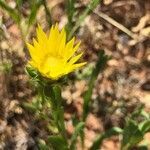Biennials or perennials (perhaps flowering first year), 30–150 cm. Stems erect, whitish, stramineous, or reddish, usually glabrous, rarely sparsely pilose near bases. Cauline leaf blades triangular, ovate, or oblong to lanceolate or linear, 25–60(–110) mm, lengths 3–12 times widths, bases cuneate or ± clasping, margins usually serrate to dentate (teeth apiculate to setose), rarely entire, apices acute to acuminate, faces usually glabrous (or, near margins, scabridulous, rarely puberulous) and usually not, rarely notably, gland-dotted. Heads usually in corymbiform arrays, rarely borne singly. Involucres broadly urceolate to globose, 8–15 × 10–20+ mm. Phyllaries in 5–6(–9) series, weakly spreading to appressed, filiform to linear or lanceolate, apices slightly recurved or straight to incurved, terete, slightly to moderately resinous. Ray florets 12–36; laminae 10–16 mm. Cypselae stramineous to grayish, 2–6 mm, apices coronate or knobby, faces smooth or striate; pappi of 2 straight, smooth (apices often dilated), setiform awns 4–8 mm, usually equaling to slightly surpassing disc corollas. 2n = 12.
More
Short-lived, monocarpic perennial sometimes sparsely hairy below, 3–15(–20) dm; lvs scarcely punctate, sharply serrate or serrulate with bristle-tipped teeth (seldom entire), acute to acuminate, the middle ones linear or lance-oblong, 4–11 cm × (2–)4–28 mm; disk 1–2 cm wide; invol bracts only slightly resinous, loose, not markedly imbricate; rays 15–30, 10–16 mm; achenes 4–6 mm; pappus-awns mostly 2, entire; 2n=12. Dry, open places, often on limestone; c. Tenn., s. Ind., and s. Ill. to Kans., Tex., and N.M. June–Sept. Ours is var. lanceolata.

